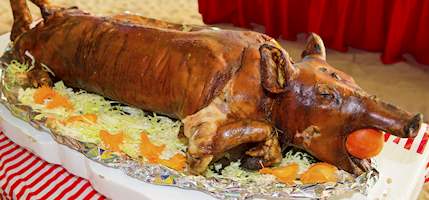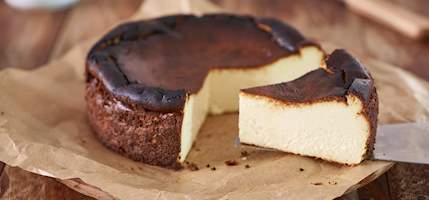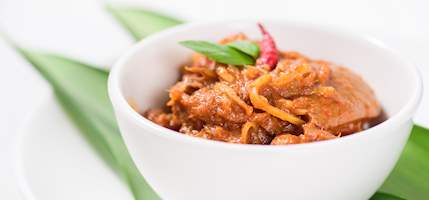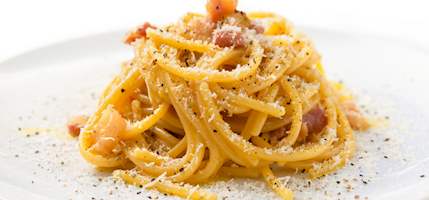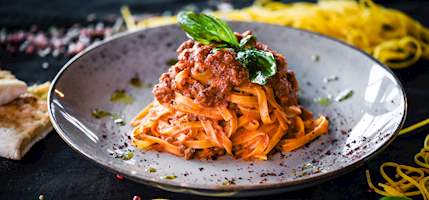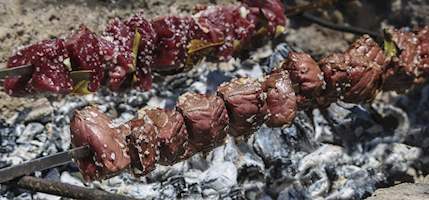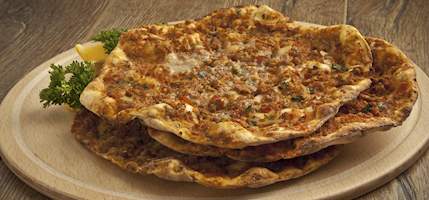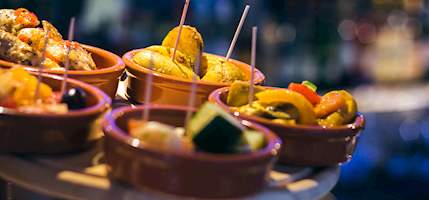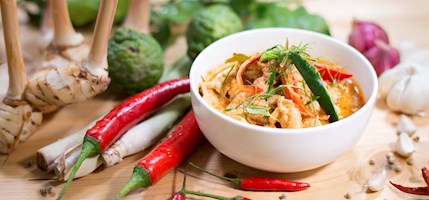Lechon
Lechon, derived from a Spanish word for roasted suckling pig is one of the most popular dishes in the Philippines. The slowly-roasted suckling pig is usually stuffed with lemongrass, tamarind, garlic, onions, and chives, and is then roasted on a large bamboo spit over an open fire. It is traditionally served whole on a platter, at celebrations and festive events such as weddings and Christmas. Once the meat is properly roasted and falls off the bone, people tend to eat every part of the pig, and the crispy, reddish-brown, crackling skin is especially beloved. Lechon is often served with a thick and rich liver sauce that is cooked with sugar, fresh herbs, and vinegar. If anything is left after the feast, the leftovers are often made into lechon slaw, slowly cooked with vinegar, garlic, and liver sauce for that extra bit of flavor. Apart from the Philippines, the dish is especially popular in countries such as Cuba, Puerto Rico, the Dominican Republic, and Spain. Some famous chefs even named lechon the best pig in the world, so it is definitely worth a try.
Basque Cheesecake
Known simply as tarta de queso or gazta tarta in its native Basque, this simple yet incredibly creamy cheesecake variation is a decades-old local specialty of the La Viña Bar in San Sebastián. The recipe is a simple combination of classic cheesecake ingredients such as sugar, heavy cream, eggs, and cream cheese, but unlike its more popular counterparts, this Basque version does not have any crust. Instead, it is baked on a high temperature which leaves the outside firm, darker, and somewhat burnt, while the center remains gooey. Basque cheesecake is immensely popular, and while La Viña remains its place of origin, different variations are nowadays found in several patisseries around the world.
Kaeng hang le
Kaeng hang le is Northern Thai curry variety that was modeled on a similar Burmese dish. The dish consists of a curry base that is usually made with dried chili peppers, lemongrass, galangal, shrimp paste, garlic, and shallots, while other ingredients usually include pork, mainly pork belly, tamarind juice, peanuts, pineapple, and shallots. Variations of the dish are found throughout the region, and they may even include other types of meat or seafood. Before it is served, this traditional curry is usually garnished with thin strips of freshly sliced ginger.
Baklava
The remarkable baklava is a luscious dessert created with layers of thin phyllo dough intertwined with chopped nuts, all doused in a sweet, viscous syrup. The popularity of baklava has long surpassed borders, regions, and ethnic groups to become a dessert whose origin and invention is claimed by numerous countries. It is probable that it has an Assyrian origin, dating back to the 8th century, from where it spread out throughout the region all the way to Greece. The Greeks altered the recipe and created the thin sheets, known today as phyllo dough, but modern-day baklava is believed to be an original Turkish creation. However, it is almost impossible to pinpoint baklava's exact place of origin, and the debate about its authenticity is still going on between Türkiye and Greece. Traditionally, baklava is made with sheets of paper-thin pastry at the bottom, followed by chopped nuts which are then topped with additional pastry layers. The other traditional way suggests alternating layers of phyllo dough with layers of chopped nuts. The original and authentic baklava should always have a nut-based filling, most commonly walnuts, hazelnuts, or pistachios, but modern versions have introduced unusual fillings such as apricots, chocolate, and even ground cookies. The dessert is typically prepared in large trays, and it is then sliced into squares, triangles, or diamond shapes before being doused in a luscious syrup made with water and sugar or honey. Very often, the syrup is flavored with sliced lemon, rose water, cinnamon, or cardamom. It is supposed to cover the entire tray and keep the delicate pastry succulent, creating a sweet and juicy cover around it. Iranian or Persian baklava differentiates itself because it is drier and lighter than other regional varieties, and it is often flavored with rose water. Even though it was once regarded as a decadent treat that was mostly enjoyed by the aristocracy, the famous baklava is now a traditional pastry and a dessert offered in numerous Oriental, Turkish, or Greek restaurants. It is also often found in pastry shops across the Balkan region all the way to the Middle East.
Space Cake
ALTHOUGH THERE ARE CLAIMS THAT EATING SPACE CAKES CAN LEAD TO PSYCHOSIS OR PSYCHOSIS SYMPTOMS FOR SOME PEOPLE, THERE'S STILL NOT ENOUGH CONCLUSIVE SCIENTIFIC EVIDENCE TO SUPPORT THEM. Originating from Amsterdam, space cake is a notorious delicacy that belongs to a group of cannabis-infused edibles. Variations on this specialty abound, and any baked good that contains cannabis butter may be called a space cake. This Dutch specialty is usually prepared with typical cake ingredients such as flour, sugar, baking powder, butter, milk, and eggs, which are combined with a certain quantity of cannabis. A great variety of ingredients can be added to the base to enrich the cake, including cocoa powder, chocolate drops, dried fruit, buttercream, vanilla, or various spices, and the baked cakes often come dusted with powdered sugar, glazed, soaked in rum, or stuffed with cream or custard. As with other cannabis intake methods, the consumption of cannabis in the form of space cakes also provides psychotropic effects upon its consumers due to the presence of THC (tetrahydrocannabinol) and other compounds. In the case of space cakes, the effects are usually prolonged and much stronger, and consumers typically feel high within 3 hours from the consumption. Space cakes with different shapes, flavors, and varying strengths can be savored at nearly any coffee shop in Amsterdam and they’re typically enjoyed alongside a cup of coffee, herbal tea, or beer. When it comes to the legal status of these cakes in the Netherlands, the country’s court allows the sale only of those cakes that are made with crushed weed.
Kepta duona
Kepta duona is a simple Lithuanian snack consisting of sliced rye bread that is shortly fried until crispy. The bread is usually sliced into thin strips before it is pan-fried in oil, and it is usually rubbed with garlic (duona su česnaku), while modern varieties often come topped with cheese (duona su sūriu) or mayonnaise. This snack is commonly served in bars, and it is often paired with beer or gira (kvass).
Pasta carbonara
The carbonara we know today is prepared by simply tossing spaghetti with guanciale (cured pork jowl), egg yolks, and Pecorino Romano cheese. Despite its simplicity, this dish remains one of Rome's favorites, equally popular throughout the country. Even though carbonara is considered a typical Roman dish today, its origins are quite vague and often disputed. The name is said to have been derived from the carbonari, woodcutters and charcoal-makers who lived in the Appenine mountains northeast of Rome, and who supposedly cooked their pasta over a hardwood charcoal fire and tossed it with eggs and cheese. Another popular theory claims that carbonara was invented after the liberation of Rome in 1944, when food shortages were so severe that Allied troops distributed bacon and powdered eggs, which the local population would then mix with water to make pasta sauce.
Tagliatelle al ragù alla Bolognese
Tagliatelle al ragù alla Bolognese is a traditional Italian dish originating from Bologna, consisting of tagliatelle pasta and a rich ragù made with a mixture of minced beef and pork, and tomatoes as key ingredients. Even though they are often thought to be synonymous, tagliatelle al ragù—one of Bologna's signature dishes—bears little or no resemblance to the dish known as spaghetti Bolognese in the rest of the world. In fact, the world famous Italian ragù alla Bolognese meat sauce is never served with spaghetti in Bologna. Instead, when it isn't served over fresh tagliatelle, you will most often find it topping a bed of some other other ribbon-like pasta, such as fettuccine or pappardelle. Regardless of the type of pasta used, what makes or breaks this classic Emilian dish is the ragù itself. Experts nowadays tend to consider the recipe for ragù alla Bolognese registered by the Italian Academy of Cuisine in October 1982 the most authentic version. However, chances are that every restaurant and trattoria in Emilia Romagna dishes out its own version of tagliatelle al ragù, and each version is surely worth trying.
Pastel de nata
Pastel de nata is a traditional Portuguese egg custard tart that is popular throughout the world. It is believed that for the best result, the filling should not be too sweet and should not have flavors of lemon nor vanilla. Instead, the tarts should be sprinkled with cinnamon and, ideally, paired with a cup of coffee. Originally, this treat was made before the 18th century by Catholic monks and nuns in Santa Maria de Belém in Lisbon. The tart was made from leftover egg yolks that were used in the clearing of wines and starching of clothes. Later on, the clerics made a deal with a nearby bakery to start selling pastel de nata commercially, and the product was a huge success. It is still hugely popular, and the fact can be supported by long lines of people who are waiting on their pastel de nata in front of numerous Portuguese bakeries. However, pastel de Belém's recipe is kept secret, and only the ones produced at the Fábrica Pastéis de Belém can be called pastel de Belém, while all the other egg custard tarts from other producers in Lisbon are called pastel de nata.
Medovik
Medovik is a popular Russian layered honey cake consisting of honey-infused, almost biscuit-like sponges that are coated with thin layers of cream. Although there are numerous variations of the cake, the custard is usually prepared with whipped cream or various combinations of condensed milk and butter. It is believed that the cake first appeared in the 1820s and was initially created for the wife of Alexander I of Russia. The addition of condensed milk probably originates from the Soviet era, while modern variations may include berries or even chocolate. Medovik is traditionally decorated with ground walnuts and is commonly served on various special occasions.
Šaltibarščiai
This refreshing, cold beetroot soup is a part of traditional Lithuanian cuisine. It consists of a creamy blend of pickled or boiled beetroots and tangy kefir or buttermilk, poured over grated cucumbers and hard-boiled eggs. The whole soup is generously seasoned with dill, and usually left to set until all the flavors are thoroughly combined. It is usually prepared in the summertime, and is best served chilled, preferably with potatoes on the side. It can be enjoyed as an appetizer or a light main course.
Espetada
Espetada is a traditional Portuguese dish and a specialty of the island of Madeira. It consists of big pieces of beef that are marinated in salt and garlic, then skewered on a bay leaf stick. The stick is placed over hot coals until the meat is properly cooked. It is the most popular dish to serve at picnics or parties in Madeira. Espetada is often served with the skewer hung vertically from a hook, so that the flavorful juices can drip down onto a plate filled with thick-sliced, crusty bread. Pork, sausages, and squid can all act as a substitute for beef in espetada, but then it is not a typical Madeira dish anymore. Since it is a great summer dish, it is recommended to pair espetada with a glass of cold sangria.
Gyros
Gyros is one of the most popular Greek street food dishes, consisting of meat such as pork and chicken (in Greece) or lamb and veal (popular in other countries) cooked on a vertical spit. The meat is sliced in thin shavings and is then usually placed in a pita bread along with sauces such as tzatziki and vegetables such as tomatoes, onions, lettuce, and cucumbers. Gyros is derived from the Greek word gheereezo, meaning to turn, referring to the constantly rotating vertical spit on which the meat is cooked. Some believe that gyros originated during the time of Alexander the Great, when his soldiers skewered the meat on their swords and cooked it over a fire. Others claim that gyros was introduced to Greece in 1922, with the refugees from Constantinople and Smyrna. Many of the refugees became merchants and opened their shops with tiny holes in the wall, where gyros was sold. After WWII, gyros gained popularity and spread to Europe, Australia, and the United States. Today, gyros is known as one of the most popular street food varieties around the world.
Lahmacun
Even though lahmacun is popularly nicknamed Turkish pizza, that name doesn't really do justice to what this crunchy, doughy treat topped with spicy minced meat truly represents. In Turkey, lahmacun is the ultimate street food and a favorite lunchtime snack. It can be found at numerous street stalls as well as in virtually any traditional Turkish restaurant, but also in kebab eateries where they typically serve mini lahmacuns as appetizers. The perfect lahmacun is made by rolling a ball of sturdy semolina dough into a thin disc which is only lightly spread with meat - either lamb or beef, minced to a paste together with chili, onions, and other seasonings. The dish is then shortly baked in a super-hot (and preferably wood-fired) oven. Lahmacun is best served hot with a drizzle of lemon juice. It is traditionally enjoyed folded around the crispy onions and a parsley salad known as piyaz. It is recommended to pair lahmacun either with the salty, cold yogurt beverage called ayran, or şalgam suyu, the barrel-fermented juice of red carrot pickles, which is salted, spiced, and flavored with the aromatic turnip called çelem.
Picanha
Picanha is a fresh cut of beef that's especially popular and highly prized in Brazil. In the US, it's called sirloin cap, and in the UK, it's known as the rump cap. Picanha is situated on the back side of the animal, above the butt, where it sits on a fat cap. It's mostly used for churrasco – the meat is first grilled, then sliced off of a skewer. This cut holds very little fat in the meat, so it must be cooked perfectly in order not to make it tough. In Brazil, every churrasco has picanha, and all of the best churrascarias feature picanha on their menus. The name picanha is derived from the word picana, referring to the ranchers' pole used for herding cattle in Portugal and Spain. The technique was brought over to Brazil where the word picanha was used to refer to the part of the cow that was poked by ranchers with the pole.
Pizza
The story of the invention of this everyday household name changes depending on how you define it. If you think a pizza is an oven-baked flatbread, its origins lie in the ancient Middle East. If pizza must have toppings, its origins date back to the ancient Romans and Greeks, who baked flatbreads and topped them with available, local spices and olive oil. But the pizza we all know today, made with tomato sauce, cheese, and numerous toppings, originated in Italy. It became popular in Naples in the 18th century as a cheap, nourishing food that was consumed mainly by peasants. The modern pizza as we know it today evolved from early Neapolitan flatbreads topped with lard, salt, and garlic. No one knows when or why the tomato first began being used in the preparation of pizza, but it is known that they were first recorded in Italy in 1544. While most Europeans initially disparaged them as poisonous, the southern Italians embraced them, giving them the name pomi d’oro (golden apples). Although some say that tomatoes have been used on pizza marinara since 1734, others claim that they were not used until the early 19th century. The Italians credit Raffaele Esposito of Pizzeria Brandi as having invented the first modern pizza in 1889. He was supposed to make a variety of pizzas for the queen, so he made one with lard, cheese, and basil, one with fish, and one with mozzarella, basil, and tomatoes. Known as pizza alla mozzarella at the time, this last pizza later became known as pizza margherita, once the queen declared it as her favorite. Interestingly enough, the colors of the margherita are the same as those found on the Italian flag. Pizza crossed over the Italian border shortly thereafter, to Spain, France, England, and the United States, where it was introduced by Italian immigrants. However, it didn’t gain much popularity until after World War II. In the United States, the first pizzeria was opened in New York City by Gennaro Lombardi in 1905, and since then it has become one of the most popular food items in the United States. In an ironic twist of fate, American-style pizza has been re-exported back to Italy, where it is has also gained in popularity today. In 2008, two Italian associations called Real Pizza and the Association of Neapolitan Pizza-makers introduced new regulations on what constitutes a true Neapolitan pizza. According to them, the real, legally-protected Neapolitan margherita should be made with exact amounts of mozzarella, salt, and tomatoes, and it should be baked in a wood-fired oven at 485°C. Today, there are numerous variations of this beloved dish throughout the world, from those with simple toppings such as ham, prosciutto, onions, and bell peppers, to unusual variations such as hot dog or hamburger pizza or decadent toppings such as white truffles, edible gold, lobster, and caviar.
Tapas
Popularly known as Spain's greatest food invention, these small finger foods are usually accompanied by a few drinks at lunchtime or in the early evening, led by the philosophy "eat when you drink, drink when you eat." The name originates from the Spanish verb tapar, which means to cover, and the dish stems from the region of Andalusia where drinkers would cover their glasses with slices of bread or meat to keep out the dust and flies. Today, the popularity of tapas has brought them across the borders of Spain, and tapas bars can now be found in nearly every developed country. Classic tapas were all about shellfish, originally consisting of a few olives, mussels, or anchovies served on a tiny plate. Today, however there is no end to the variety in modern tapas, which can be assembled from almost any type of ingredient served in small portions, with virtually no rules as to what goes with what. In southern Spain, tapas include shellfish, squid, eggs, shrimp, mixed breaded seafood, and fried fish marinated in saffron. Tapas in the north often consist of béchamel-based croquettes and battered prawns, while Madrid loves tripe, anchovies cured in vinegar, and ham tapas. Other common varieties include olives, meatballs, stuffed mussels, green peppers, cured cheeses, and thinly sliced salted cod. Regardless of the variety, tapas are a staple in Spain, amazing bar food worldwide, a way of eating, and a way of living.
Phanaeng Curry
Phanaeng curry is a variety of Thai curry that is characterized by a thick texture and salty-sweet peanut flavor. It consists of meat that is stewed with coconut milk, panang curry paste, makrut lime leaves, fish sauce, and palm sugar. The meat used in phanaeng curry is usually beef, chicken, duck, or pork, and the dish traditionally does not include any vegetables. The name of the dish is derived from the word panang, meaning cross, which refers to the ancient way of preparing chicken with its legs crossed and set in an upright position. Though the origins of phanaeng curry are somewhat murky, it is often associated with the Malaysian state of Penang, but there is little evidence to support this claim. However, the earliest known recipe is found in Maawm Sohm Jeen’s book Tam Raa Gap Khao, dating back to 1890. Once finished, the curry is garnished with thinly sliced makrut lime leaves and Thai spur chili slices, and a bit of coconut milk can be poured over the curry.
Tiramisù
Even though tiramisù is actually a fairly recent invention, this dessert of coffee-soaked ladyfingers layered with mascarpone cream enjoys an iconic status among Italian desserts. Its name stems from the phrase tirami sù, an Italian expression which literally means pick me up, a reference to the uplifting effects of sugar, liquor, and coffee. The origins of tiramisù are heavily disputed between Veneto and Friuli-Venezia Giulia regions, but it is often suggested that the first was made in Veneto in the early 1960s. The earliest documented recipe for tiramisù (interestingly, without alcohol!) was printed in the 1981 spring edition of Vin Veneto magazine in an article on coffee-based desserts by Giuseppe Maffioli, a renowned food critic and member of the Italian Academy of Cuisine. However, in August 2017, Friuli-Venezia Giulia's tiramisu was officially added to the list of traditional regional dishes, but a Veneto local won the Tiramisu World Cup in November 2017, so the playing field is somewhat levelled once again. Regardless of these disputes, the perfect tiramisù should always deliver a serious caffeine kick from a shot of strong espresso, while brandy-fortified Marsala wine adds a nice sweet buzz. In 2021, Ado Campeol, the owner of the restaurant where tiramisù is widely thought to have been invented, has died.
Roti canai
Roti canai is a traditional pan-fried flatbread made with flour, water, eggs, and fat of Indian origin, but mainly associated with Malaysia, and surrounding countries like Indonesia, Brunei, and Thailand. The dough for roti canai is repeatedly folded, so the final product has a layered texture, a soft interior, and a crispy outer layer. The most common fat used in roti canai is ghee, the traditional Indian clarified butter. It is believed that the dish originated in India when the Indian laborers who migrated to Malaysia brought the recipe and the tradition of preparing this crispy pastry to the foreign country. Usually, it is served plain in its traditional round form, as an accompaniment to curries. It can be served on the side or torn into pieces and mixed with the curry. However, roti canai is often served as the star dish, accompanied by different savory and sweet fillings and ingredients. If additional fillings are added, roti canai is usually shaped into rectangles. For example, in Malaysia, one can find various roti canai types, which are differentiated by the type of filling — egg, onion, egg and onion, banana, sardines, margarine and sugar, Maggi instant noodles, cheese, vegetable, and pork filling are some of the many available. However, roti canai doesn't have to have a filling but only a topping, such as fried eggs, curry, beans, lentils, and coffee beans. But martabak, a thick roti filled with meats, eggs, onions, and spices, is probably the best-known type of roti canai. Apart from Malaysia, it can also be found in Saudi Arabia, Yemen, and a few other countries. Other than Malaysia, a very similar type of flatbread can be found in Singapore, where it's called roti prata. This crispy bread is usually sold by street vendors called mamaks.

